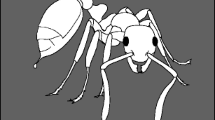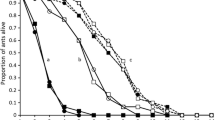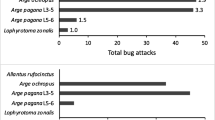Summary
When disturbed, two species of Malayan Pachycondyla release foam threads more than 10 cm in length or foam piles. The source of the proteinaceous foam is the enlarged venom gland, which is probably frothed up by air from the spiracles of the spiracular plates. The Dufour's gland normally producing hydrocarbons in stinging ants is atrophied. Therefore, absence of the Dufour's gland could be essential to the foaming ability, since the lipophilic hydrocarbons inhibit froth production in protein solutions. The release of foam is a mechanically acting defense mechanism, which is very effective against small mass-attacking ants. Pachycondyla species are also able to sting effectively.
Similar content being viewed by others
References
Bingham CT (1903) The fauna of British India, including Ceylon and Burma. Hymenoptera II: Ants and cockoo wasps. Taylor and Francis, London
Blum MS, Hermann HR (1978) Venoms and venom apparatus of the Formicidae: Myrmeciinae, Ponerinae, Dorylinae, Pseudomyrmicinae, Myrmicinae and Formicinae. In: Bettini S (ed) Arthropod venoms. Springer, Berlin Heidelberg New York (Handbook of Experimental Pharmacology, vol 48, pp 661–690)
Carpenter GDH, Eltrinham H (1938) An audible emission of defensive froth by insects. With an appendix on the anatomical structures concerned in a moth. Proc Zool Soc (Ser A) 243–252
Eisner T, Hendry LB, Peakall DB, Meinwald J (1971) 2,5-Dichlorophenol from ingested herbicide in defensive secretion of grasshoppers. Science 172:277–278
Eisner T, Tappey HJD, Aneshansley W, Tschinkel WR, Silberglied RE, Meinwald J (1977) Chemistry of defensive secretions of bombardier beetles (Brachinini, Metriini, Ozaenini, Paussini). J Insect Physiol 23:1383–1386
Feigl F (1960) Tüpfelanalyse. Akademische Verlagsgesellschaft, Frankfurt
Jessen K, Maschwitz U, Hahn M (1979) Neue Abdominaldrüsen bei Ameisen. I. Ponerini (Formicidae: Ponerinae). Zoomorphologie 94:49–66
Maschwitz U (1975) Old and new chemical weapons in ants. Proc IUSSI Congr, Dijon, pp 41–45
Maschwitz U, Kloft W (1971) Morphology and function of the venom apparatus of bees, wasps, ants and caterpillars. In: Bücherl W, Buckley EE (eds) Venomous animals and their venoms, vol 3. Academic Press, New York London, pp 1–60
Maschwitz U, Hahn M, Schönegge P (1979) Paralysis of prey in ponerine ants. Naturwissenschafter 66:213
Schildknecht H (1970) The defensive chemistry of land and water beetles. Angew Chem Int Ed Engl 9:1–9
Author information
Authors and Affiliations
Rights and permissions
About this article
Cite this article
Maschwitz, U., Jessen, K. & Maschwitz, E. Foaming in Pachycondyla: A new defense mechanism in ants. Behav Ecol Sociobiol 9, 79–81 (1981). https://doi.org/10.1007/BF00299857
Received:
Accepted:
Issue Date:
DOI: https://doi.org/10.1007/BF00299857




